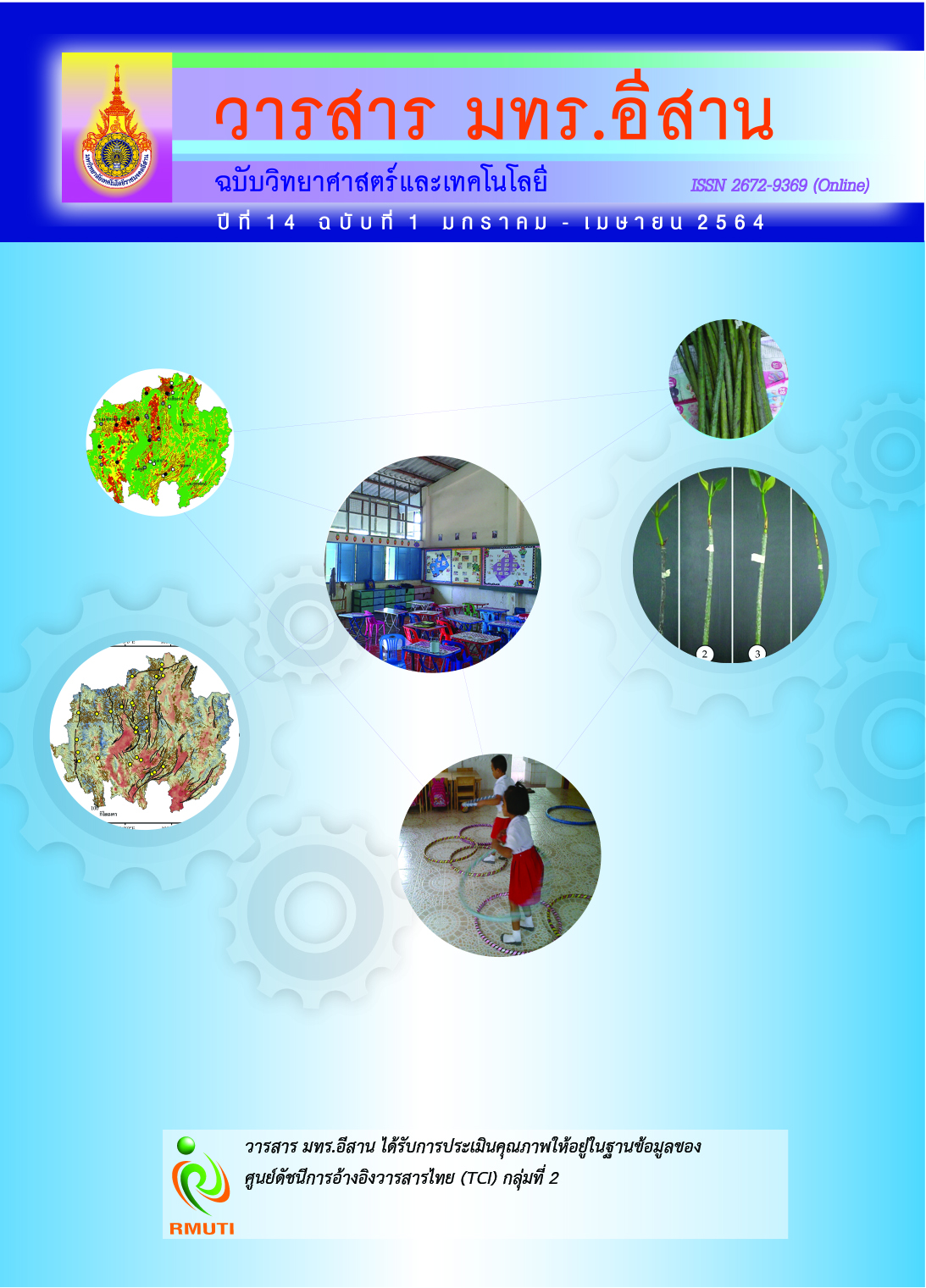Growth Performance, Carbohydrate and Protein Digestibility of Labeo chrysophekadion Fed with Okra Supplemented Feed
Main Article Content
Abstract
The aim of this study were to investigate on in vitro carbohydrate and protein digestibility in feedstuffs and feed of Black shark minnow and detect the optimal level of okra supplementation. Black shark minnow with an initial weight and length were 3.11±0.61 g/fish and 7.05±0.60 cm./fish respectively. The completely randomize design was arrange to 4 treatments with 3 replications. Fish fed okra supplement at 0, 2, 4 and 6 % with isonitrogenous diet at 36.70 % protein for 16 week. The results showed that wheat flour and okra have the highest carbohydrate digestibility as 62.48 and 48.67 μmol maltose/g feed/amylase activity (P < 0.05). Protein digestibility was the highest in fish meal as 50.74±2.47 μmol DL-alanine equivalent/g feed/trypsin activity (P < 0.05). Carbohydrate digestibility was significantly in feed supplemented with okra at 0 % compared with other groups (P < 0.05). In addition, protein digestibility was significant highest in dietary supplemented with okra at 2 - 6 % compared with control group (P < 0.05). Growth performance and protein efficiency ratio of fish fed with supplemented okra at 2 % has higher than other groups (P < 0.05). On the other hand, survival rate and feed conversion ratio were not significant different among groups (P > 0.05).
Article Details
References
Uk-katawewat, S. and Pongchawee, K. (2543). Taxonomy of Ornamental Fish for Thailand Exports. Bangkok: Fisheries Department
Vidthayanon, C. (2547). Handbook of Freshwater Fishes. Bangkok: Bangkoksarakadee Press
Ingram, B. A. and Lasasimma, O. (2008). Production of Cirrhinusmolitorella and Labeo chrysophekadionfor Culture Based Fisheries Development in Lao PDR. Part 1. Captive Spawning. Aquaculture Asia. Vol. 13, No. 2, pp. 24-31
Chitmanat, C. (2551). Fish Disease Handbook. Chiangmai: Maejo University Press
Shengjie, L., Renhui, H., Nagendra, P., Shah, X. T., Yonghua, X., and Hua, W. (2014). Antioxidant and antibacterial activities of exopolysaccharides from Bifidobacterium bifidum WBIN03 and Lactobacillus plantarum R315. Journal of Dairy Science. Vol. 97, Issue 12, pp. 7334-7343. DOI: 10.3168/jds.2014-7912
Kumar, D. S., Tony, D. E., Kumar, A. P., Kumar, K. A., Rao, D. B. S., and Nadendla, R. (2013). A REVIEW ON: Abelmoschus esculentus (OKRA). International Research Journal of Pharmaceutical and AppliedSciences (IRJPAS). Vol. 3, No. 4, pp. 129-132
Mizuno, T., Wang, G., Zhang, J., Kawagishi, H., Nishitoba, T., and Li, J. (1995). Ganoderma lucidum and Ganodermatsugae: Bioactive Substances and Medical Effects. Food Reviews International. Vol. 11, Issue 1, pp. 151-166. DOI: 10.1080/87559129509541025
Shyang, C. S. and Mei, H. L. (2012). Composition Analysis and Immuno-Modulatory Effect of Okra (Abelmoschus esculentus L.) Extract. Food Chemistry. Vol. 134, No. 4, pp.1906-1911. DOI : 10.1016/j.foodchem.2012.03.110
Areekijseree, M., Engkagul, A., Kovitvadhi, U., Thongpan, A., Mingmuang, M., Pakkong, P. and Torrissen, K. R. (2004). Temperature and pH Characteristics of Amylase and Proteinase of Adult Freshwater Pearl Mussel, Hyriopsis (Hyriopsis) bialatus Simpson 1900. Aquaculture. Vol. 234, No. 1-4, pp. 575-587
Rungruangsak, T. K., Moss, R., Andresen, L. H., Berg, A., and Waagbø, R. (2006). Different Expressions of Trypsin and Chymotrypsin in Relation to Growth in Atlantic Salmon (Salmo Salar L.). Fish Physiol Biochem. Vol. 32, No. 1, pp. 7-23. DOI: 10.1007/s10695-005-0630-5
Roghieh, S., Seyed, H., Hoseinifar, H. V. D., and Maryam, D. (2017). The Effects of Dietary Myrtle (Myrtus communis) on Skin Mucus Immune Parameters and mRNA Levels of Growth, Antioxidant and Immune Related Genes in Zebrafish (Danio rerio). Fish Shellfish Immunol. Vol. 66, pp. 264-269. DOI: 10.1016/j.fsi.2017.05.007
Rainboth, W. J. (1996). The Taxonomy, Systematics, and Zoogeography of Hypsibarbus, a New Genus of Large Barbs (Pisces, Cyprinidae) from the Rrivers of Southeastern Asia. Zoology. Vol. 129, No. 1-13, pp. 1-199
Chuapoehuk, W. (2543). Aquatic Animal Nutrition and Feeding. 2nd ed. Bangkok: Kasetsart University Press
De Silva, S. S. and Anderson, T. A. (1994). Fish Nutrition in Aquaculture. London: Chapman & Hall
Halver, J. E. and Hardy, R. W. (2002). Fish Nutrition. 3rd ed. New York: Academic Press
Kumar, A., Baranwal, D. K., Aparna, J., and Srivastav, K. (2013). Combining Ability and Heterosis for Yield and its Contributing Characters in Okra (Abelmoschus esculantus (L.) Moench). Madras Agricultural Journal. Vol. 100, No. 1-3, pp. 30-35
Siriphat, D. (1998). Red/Green Okra Taste and Value. Access (7 October 2017). Available (https://www.doctor.or.th/article/detail/2421)
Pamornprawat, S. (2008). Okra. Access (7 October 2017). Available (https://www.doctor.or.th/article/detail/1186)
Thammarutwasik, P., Hongpattarakere, T., Chantachum, S., Kijroongrojana, K., Itharat, A., Reanmongkol, W., Tewtrakul, S., and Ooraikul, B. (2009). Prebiotics - A Review. Songklanakarin Journal of Science and Technology. Vol. 31, No. 4, pp. 401-408
Wichienchot, S., Hongpattarakere, P., Jongjareonrak, A., Chansuwan, W., Hmadhlu, P., Hongpattarakere, T., Itharat, A., and Ooraikul, B. (2011). Extraction and Analysis of Prebiotics from Selected Plants from Southern Thailand. Songklanakarin Journal of Science and Technology (SJST). Vol. 33, No. 5, pp. 517-523
Bawa, S. N. and Badrie, N. (2016). Nutrient Profile, Bioactive Components, and Functional Properties of Okra (Abelmoschus esculentus (L.) Moench). Fruits, Vegetables, and Herbs. In: (Watson, R, and Preedy, V.). Bioactive Foods in Health Promotion. (1st ed). pp. 365-409. London: Academic Press


